A Roll of Arms of the Lands of Legend
The practice of warriors decorating their shields dates back into antiquity. At times designs have simply been whatever took an individual's fancy, but at other times, particular signs or symbols became associated with a particular person, or family, or settlement or region, or even entire countries - the Wolf and Eagle symbols of the Selentine Empire were well known throughout the lands they took under their control. With soldiers in armour, and large bodies of men in battle, the use of symbols to ensure a person could identify friend from foe was often critical.
In the lands of Legend, over time, rules and conventions governing the use of such symbols have been developed and are still developing. The art of Heraldry is becoming more and more significant. In some of the more genteel kingdoms, such as Chaubrette and Algandy, where traditional ways for a Noble, Knight, or gentleman to display his status and position are less common than they used to be, the rules can be very elaborate, in kingdoms such as Albion, organised heraldry is a newer idea, but one that is being embraced with the support of the Crown.
On this page, I intend to give an overview of the symbols - truly heraldic and otherwise - of the major powers of the known world of Legend.
The Kingdom of Albion
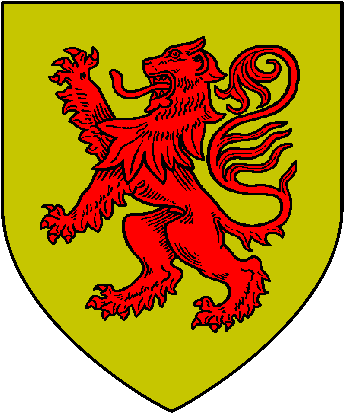
As is common with the kingdoms that follow the True Faith in Albion, the symbol of Albion is the King's own Coat of Arms. It has been used by successive Kings of Albion for most of the last century. It shows a red lion rampant on a field of gold. Other members of the royal family have similar shields showing a red beast rampant on a field of gold and the King has granted permission to certain of his most loyal nobles to bear a red beast rampant on some other field besides plain gold - if you see such a device in Albion, it will normally be a sign of royal favour as the King's Heralds have claimed authority over such matters and do their best to be involved in any new creation of arms. Other nations are not required to follow this convention, but, in practice, heralds are unlikely to create new arms that violate it, for fear of causing confusion, so if such shields are seen elsewhere, they are probably old grants of arms.
The Kingdom of Thuland
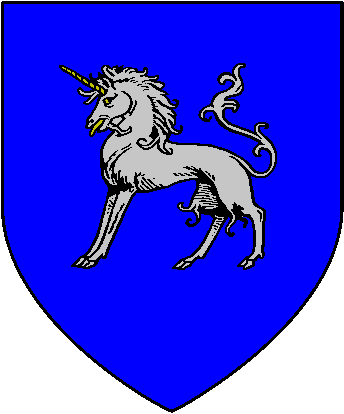
Again, the symbol of Thuland are the arms of the King of Thuland. Heraldry is still a very new idea in Thuland, with many of its warriors cautious about the idea, but senior nobles have been persuaded to take coats of arms, as they are, at least useful in dealing with interests in other Kingdoms - if you are an Earl, you want people to recognise you as such. The silver unicorn on a blue field of the King is fairly typical of Thulandish arms at present - most are simple with little in the way of halving or quartering. Some arms are passed from father to son, but the Thulanders who have embraced heraldry often feel that it is better to show off your own achievements than those of your family, if you have your own achievements.
The Kingdom of Cornumbria
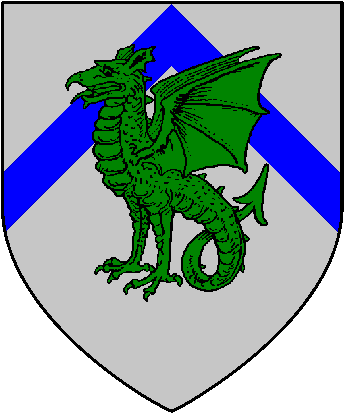
The arms of Cornumbria represent a departure from the general rule that the King's arms are the nations arms. This is a reflection the fact that the High King is elected by his peers, and it could cause confusion if the symbol of the nation changed when a new High King came to power. The Green Dragon has been used as a banner in Cornumbria for hundreds of years, and the chevron device is said by some to be symbolic of the hills of the Kingdom.
The 'Kingdom' of Ereworn
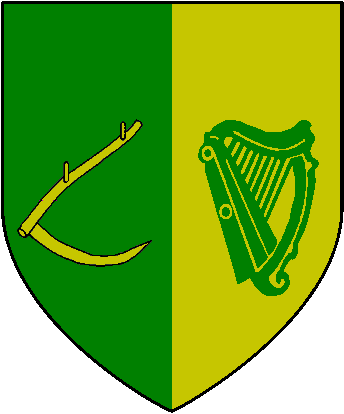
Ereworn's arms are rarely seen in use - the land is so chaotic and fractured that there is little use for a symbol of the land unified. The colours of green and gold are held to symbolise the wealth of the land, but little signs of such wealth are ever in evidence. The harp symbolises the ancient literary arts in which the Kingdom takes pride, and which its bards and minstrels take great care to preserve, and as for the scythe... officially it symbolises the harvest, but many have suggested it refers to the grim harvest of the shadowy purveyors of death who call Ereworn their home, the Clan of Harbingers. No King bears the arms of Ereworn - at present Ereworn has no King.
The Fief of Glissom
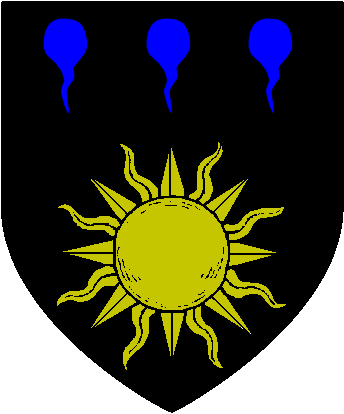
Glissom's arms are the arms of its King - which is something of a bold statement given that the King's powers are very limited outside the capital city of his fief. What symbolism lies in the arms of Glissom is poorly understood - the yellow sun is said to represent the Hearth-Fire, an important symbol in the elemental Druidic faith that dominates Glissom, and it has been suggested that the blue symbols represent the element of water - but it would be odd if the shield included only two of the four elements known to everybody, and what could the black field represent?
The Kingdom of Algandy
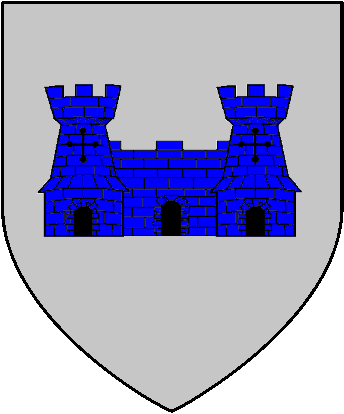
The arms of the King and Kingdom of Algandy depict a fortified city in blue on a field of silver. Almost every town and city in Algandy maintains strong perimeter defences even though the Kingdom has been at peace for many years. The people of Algandy fear their forests, which are widely held to be more the domain of elves than man, and being able to retreat behind man made defences is comforting, even if rarely actually necessary.
The Duchy of Lavasse
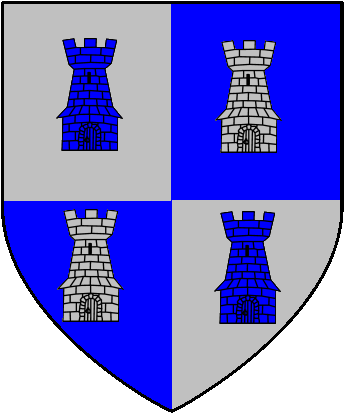
The Duchy of Lavasse owes its fealty to the Kingdom of Algandy and its coat of arms reflects this. It is very obviously based on that of Algandy. It is quartered in blue and silver, the colours of Algandy, and the watchtowers shown on the shield of Lavasse are like those seen on the fortress seen on Algandy's crest.
The Kingdom of Chaubrette
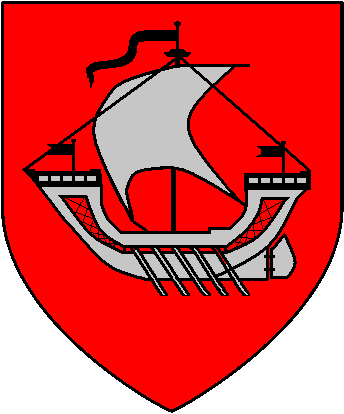
The King and Kingdom of Chaubrette bear the device of a silver ship on a field of red. The ship is a device long used as a symbol by the family of merchant Lords who, over time, have risen to rule Chaubrette as its royal family - the shield has no particular national significance, and there are Chaubrettans who feel their kingdom should, perhaps, move towards a new symbol of national unity. There is also some disquiet that the Kingdom of Albion bears red and gold on its shield, while Chaubrette bears red and silver.
The New Selentine Empire
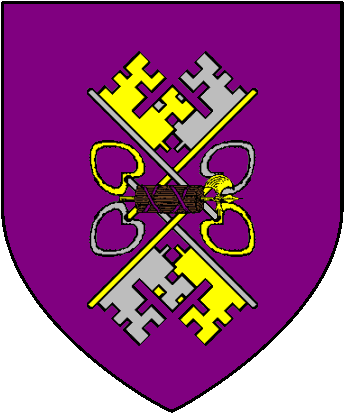
This shield is full of deliberate symbolism. The field of imperial purple reflects the fact that this is the shield of an Empire, not some mere Kingdom. The fasces (bundle of rods around an axe) at the centre of the crest has been a traditional symbol of order, control, and justice since the days of the old Empire.
The keys - in gold and silver - are a traditional symbol of the True Faith. In normal heraldry, the two metals - silver and gold - should never touch or overlap within a single device, but an exception is made to emphasise that something is particularly holy. These keys represent the keys of the Kingdom of Heaven, and their presence on the design emphasises the idea, held by the New Selentine Empire, that is remains at the centre of the True Faith.
The Kingdom of Asmulia
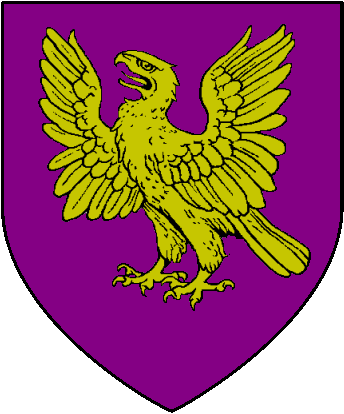
The arms of the King and Kingdom of Asmulia, like those of the New Selentine Empire, are on a field of purple, and for much the same reason. Asmulia contains the city of Selentium and the central lands of the old Selentine Empire, and while it does not claim to be an Empire, it does claim to preserve much of the imperial heritage. The golden eagle is also drawn from the eagle symbol of the old Empire.
The Kingdom of Kurland
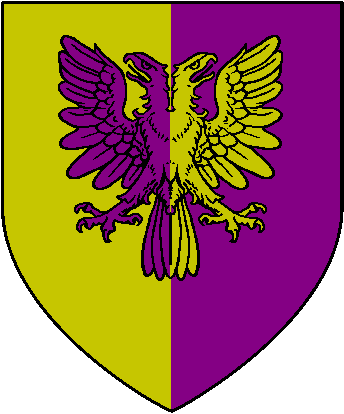
Again we have the purple and gold, and again, we have the eagle, and again for much the same reasons as we see them in Asmulia. The two headed eagle is split in half down the middle, as is the field of the shield, and is held to show that a Kingdom once divided was made whole by the greatest of Kurlish Kings, Guillarme II. Guillarme had the troops and strategic geniuses that might have allowed him to establish his own Empire across much of the northern continent if he had chosen to do so, but having secured his borders, he chose to simply rule the Kingdom he felt was his by right of birth as well as right of conquest - the two rights that are symbolised in the eagle having two heads.
The County of Braeburg
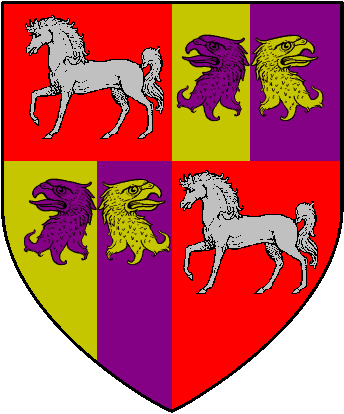
The autonomous County of Braeburg lies between Kurland and Chaubrette, and the Count swears fealty to both Kings. His shield symbolises this taking emblems and colours from the arms of Kurland and colours from the arms of Chaubrette. The silver horse is a traditional symbol of Braeburg, but some wits have noted its similarity to the unicorn on the arms of the King of Thuland and have suggested the Counts had it included as a sort of ironic comment "Maybe I should swear my allegiance to the King of Thuland too!"
The Ferromaine League
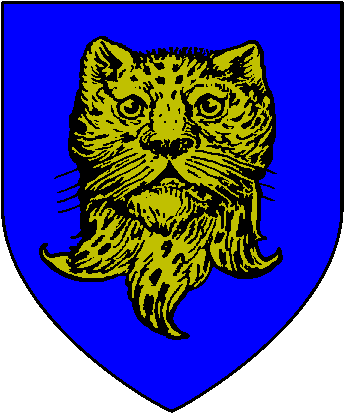
The Ferromaine League is a republic and so has no King's arms to bear. It's symbol is the symbol of the city of Ferromaine itself - a leopard on a field of blue. The blue symbolises the sea on which the traders of Ferromaine ply for their wealth, the gold, the wealth itself. The leopard is an example of the Ferromaine people taking comments meant by others as an insult as a compliment and badge of pride - the leopard is often treated in heraldry as being one and the same as a lion and it has been suggested that the people of Ferromaine are not to be trusted and never change their spots. A common Elleslandic saying about the flag of Ferromaine and those who sail under it is "Is it a leopard - or lion" with emphasis on the latter word to sound like 'lying.'
Emphidor
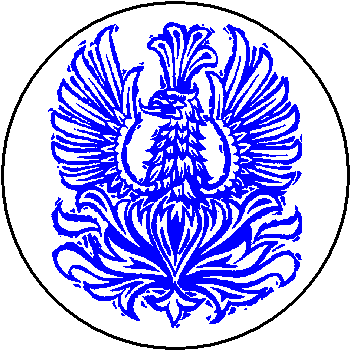
Unlike all previous devices which are commonly rendered on kite shields for illustrative purposes, even though in practice they may be displayed in many forms, the emblem of Emphidor - in common with other lands outside of the northern continent - is generally rendered within a circle - the kite shield being uncommon outside of those northern lands. Emphidor is ancient - it is known to many as a cradle civilisation for the areas around it - but it has been in decline for centuries, clinging onto existence, but only dimly reflecting its former Golden Age. Blue and white are the traditional colours of Emphidor and its symbol uses them, but also depicts a hope for the future - a phoenix rising. A land that may be reborn.
Molasaria
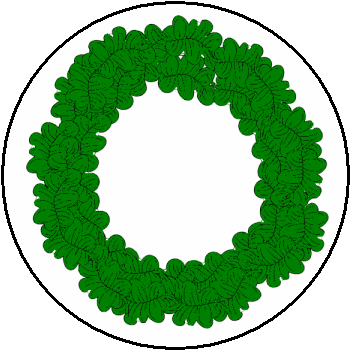
Molasaria is symbolised by an olive wreath that represents two things - its source of pride that it was never fully conquered by the Selentine Empire (appropriating a symbol of victory from the Empire itself) and the fact that the little trade it has with others tends to revolve around its olive crop.
Analika
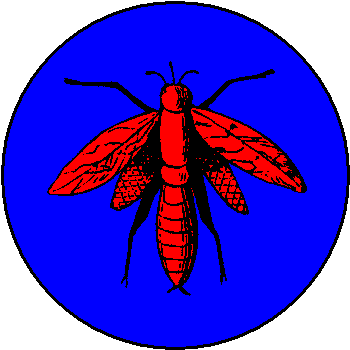
Another remnant of the lands once controlled by Emphidor, Analika's only current claim to influence in the world is that it produces a red honey mead that is highly prized for its quality and rarity among the ruling classes of the north. The red bees on its symbol symbolises this. Exactly what makes Analika's mead red is a closely guarded secret, but is believed to be part of the reason it is one of the smoothest alcoholic beverages of them all - whatever it is must be rare indeed, as people would willingly buy all of the mead they could get, but only a small quantity is ever available.
Hudristania
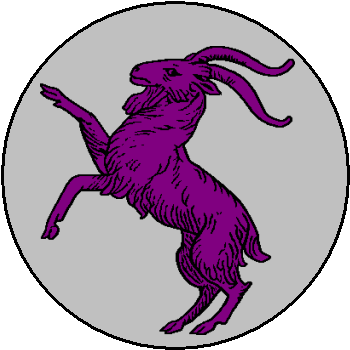
Said to be 'a mountainous region suitable only for goats', which is presumably why its symbol is a goat.
Harogarn
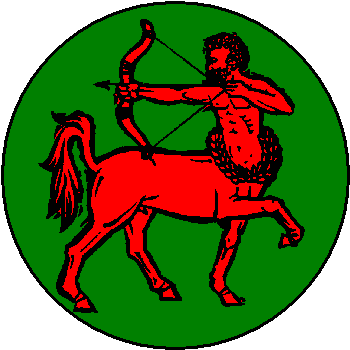
A land where the Ta'ashim faith dominates among the human population, leading to a green field but where the presence of bloodthirsty centaurs on the Gonhala Plain high on the mountains is so associated with the land that it could not help but become their symbol, despite the general practices of Ta'ashim
The Emirate of Marazid, the Caliphate of Zhenir, the Sultanate of Opalar

These three Ta'ashim nations are grouped together, because whatever symbolism is associated with their emblems is largely unknown to those from the northern lands. It is known that the Ta'ashim faith discourages imagery of living creatures and that their artwork, perhaps because of this tends to revolve around geometric designs. The colour green is considered especially important to the Ta'ashim. These two principles presumably have an influence on their national symbols.
Outremer - the Principality of the Crusades
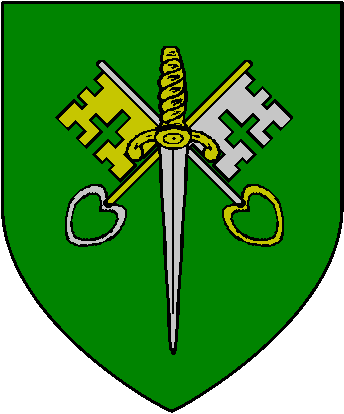
A recent addition to the Lands of Legend, carved out from lands that were in the hands of the Ta'ashim by Crusaders from the north. The green field of the shield reflects the fact that these lands were held by the Ta'ashim, the sword (and indeed the use of a kite shield in illustration) reflects the fact that it is crusading Knights who have taken these lands for the True Faith, and the keys of gold and silver depicts both the holy nature of their mission, and the holiness of the City of Crescentium.
Krarth

The Magi who rule Krarth would not tolerate a symbol that glorified the weapons and other accoutrements of a common warrior. The symbol of Krarth combined shows the five Ghosts of the Magi in symbolic form as they wheel around the skies above their desolate homeland.
The Witch-Kingdom of Wyrd
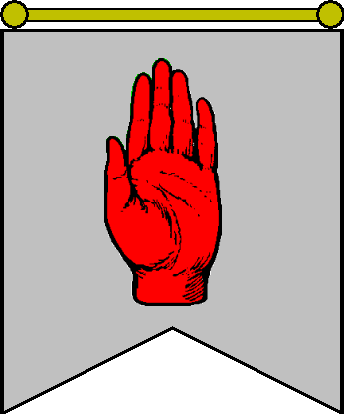
The symbol of the Witch-King of Wyrd is a blood red left-hand shown palm outwards. Nobody knows what it signifies - perhaps nobody wants to.
Return to The Great Library of Hiabuor




















